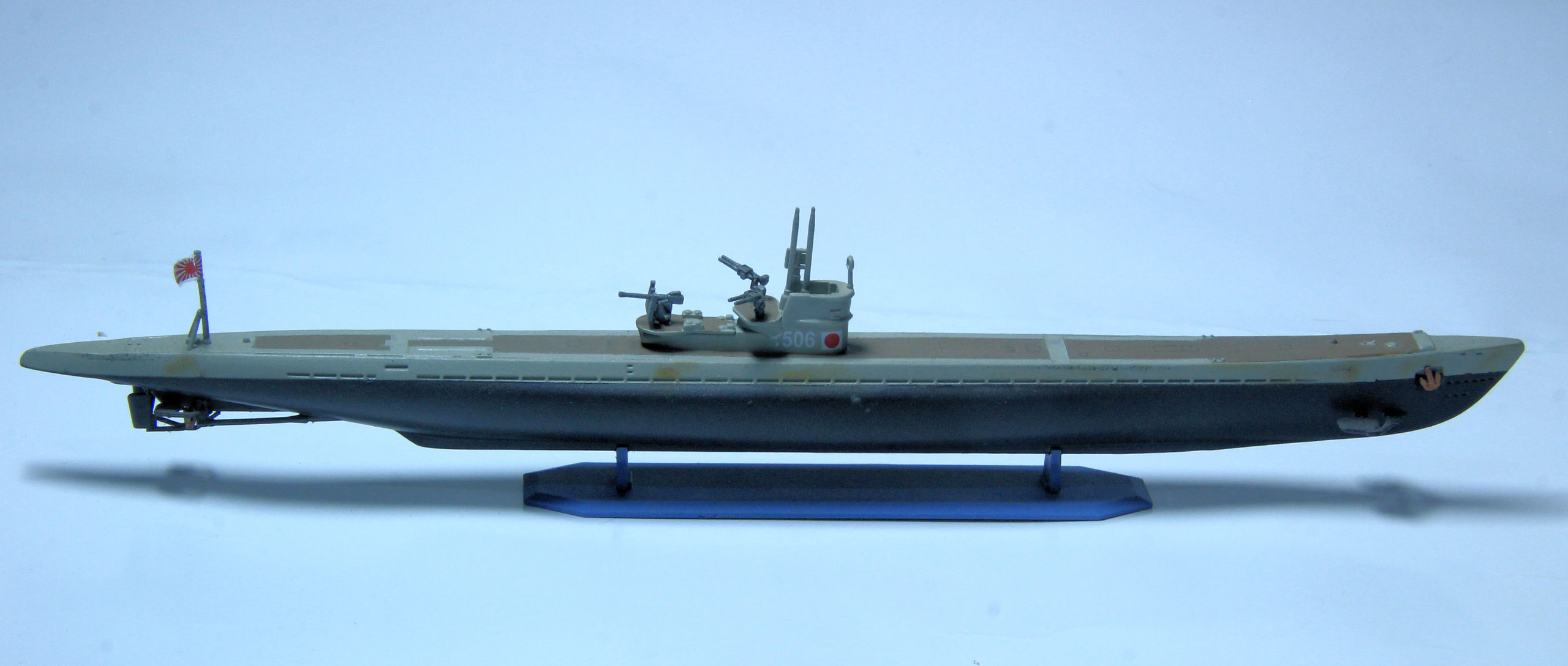Type IX U-Boat
The Type IX U-boat was designed by Nazi Germany’s Kriegsmarine in 1935 and 1936 as a large ocean-going submarine for sustained operations far from the home support facilities. Type IX boats were briefly used for patrols off the eastern United States in an attempt to disrupt the stream of troops and supplies bound for Europe. It was derived from the Type IA, and appeared in various sub-types.
Type IXs had six torpedo tubes; four at the bow and two at the stern. They carried six reloads internally and had five external torpedo containers (three at the stern and two at the bow) which stored ten additional torpedoes. The total of 22 torpedoes allowed U-boat commanders to follow a convoy and strike night after night. Some of the IXC boats were fitted for mine operations; as mine-layers they could carry 44 TMA or 66 TMB mines.
Secondary armament was provided by one 10.5 cm (4.1 in) deck gun with 180 rounds. Anti-aircraft armament differed throughout the war.
Japanese Submarine I-506 type U-IX D1 1/400 Scale Model by Mirage Hobby
U-195 was a Type IXD1 transport U-boat which served in World War II. The submarine was laid down on 15 May 1941 at the DeSchiMAG AG Weser yard in Bremen as yard number 1041, launched on 8 April 1942, and commissioned on 5 September 1942 under the command of Korvettenkapitän Heinz Buchholz.
U-195 was one of two IX-D1 transport U-boats that had their forward torpedo tubes removed and the compartment converted into a cargo hold.
1st patrol
U-195 departed Kiel on 20 March 1943 and sailed to the waters off South Africa where she sank two ships and damaged another.
On 11 April she torpedoed the American 7,200 ton liberty ship James W. Denver about 475 nmi (880 km; 547 mi) west of Las Palmas, Canary Islands. The ship, a straggler from Convoy UGS-7 en route from Baltimore to Casablanca, was loaded with sugar, acid, flour, aircraft parts, vehicles, bulldozers and had twelve P-38 Lightning aircraft as deck cargo. The crew of 69 abandoned ship in five lifeboats. The U-boat then fired two more torpedoes which sank the vessel.
Another unescorted liberty ship, Samuel Jordan Kirkwood was torpedoed on 7 May about 125 nmi (232 km; 144 mi) southeast of Ascension Island. The crew of 71 abandoned ship in four lifeboats and a raft before the U-boat sank the ship with another torpedo.
On 12 May, the unescorted 6,797 ton American merchant ship Cape Neddick was hit by two torpedoes. One failed to explode, while the other tore a hole 25 ft (7.6 m) by 30 ft (9.1 m) in the side. Still under way, the ship’s armed guards opened fire at the U-boat with their 4 in (100 mm), 3 in (76 mm), and 20 mm guns. The vessel began to sink, and most of the crew abandoned ship in two lifeboats and three rafts. After more than an hour the master and six volunteers re-boarded the ship and got her under way, just as U-195 fired another torpedo, which missed. The next day, the ship returned to pick up the men in the boats and rafts, and on 16 May arrived safely at Walvis Bay, South Africa. U-195 arrived at Bordeaux on 23 July after a patrol lasting 126 days.
2nd patrol
Now under the command of Oblt.z.S. Friedrich Steinfeldt, U-195 left Bordeaux in occupied France on 24 August 1944 and arrived at Batavia (now part of Indonesia), 127 days later on 28 December.
Amongst her cargo were parts of 12 dismantled V-2 rockets for the Japanese military. U-219 also carried part of the same V-2 rocket consignment. Both U-boats arrived at Batavia in December 1944. These two U-boats are also thought to have carried Uranium oxide requested for Japan’s atomic bomb project by General Toranouke Kawashima in July 1943. The signals requesting Uranium were part of the PURPLE decrypts which have since been declassified by the United States. U-195 head north to Brunei in order to refuel for the next journey.
3rd patrol
U-195’s final patrol involved an abortive attempt by several U-boats to sail back to Europe. Leaving Batavia on 19 January 1945 she sailed out into the Indian Ocean, south of Madagascar. There she refuelled U-boats of the Monsun Gruppe and then returned to Batavia on 4 March.
Imperial Japanese Navy
After Germany’s surrender in early May 1945, U-195 was taken over by the Imperial Japanese Navy and was commissioned as I-506 on 15 July. The U-boat surrendered to the Allies at Batavia in August 1945, she was scuttled later that month and was broken up in 1947.

Japanese Submarine I-506 type U-IX D1 1/400 Scale Model by Mirage Hobby 
Japanese Submarine I-506 type U-IX D1 1/400 Scale Model by Mirage Hobby 
Japanese Submarine I-506 type U-IX D1 1/400 Scale Model by Mirage Hobby 
Japanese Submarine I-506 type U-IX D1 1/400 Scale Model by Mirage Hobby 
Japanese Submarine I-506 type U-IX D1 1/400 Scale Model by Mirage Hobby 
Japanese Submarine I-506 type U-IX D1 1/400 Scale Model by Mirage Hobby 
Japanese Submarine I-506 type U-IX D1 1/400 Scale Model by Mirage Hobby 
Japanese Submarine I-506 type U-IX D1 1/400 Scale Model by Mirage Hobby 
Japanese Submarine I-506 type U-IX D1 1/400 Scale Model by Mirage Hobby Box Art

